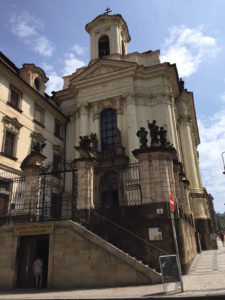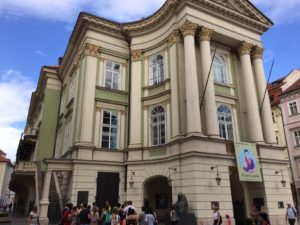
I should also mention that through some erroneous assumptions we believed we were hiring a Christian guide.
We got off to a decent start, at Vysehrad Fortress, the oldest settlement in Prague. The highlight there was the Basilica of St. Peter and St. Paul, which was built in the 11th century. Prague’s unique history made this church subject to both Byzantine Orthodox and Roman Catholic influences. Usually churches are clearly one or the other, and it is not difficult to see the difference. This church was was a mixture of both.
We rode the local rail to Charles Square and then walked a few blocks to St. Cyril and Methodius Cathedral, a church dedicated to the memory of the two highly educated Byzantine missionaries invited by the Slavs in the 9th century to create for them a written language (they only had a spoken language). According to Cyril’s biographer, who wrote within ten years of his death, through prayer God revealed to Cyril letters that formed the alphabet that would eventually become what we know as Cyrillic. Philoligists who have studied Cyril’s alphabet are at a loss to explain from what other language he borrowed the letters because they seem wholly original, which is what you would expect if he was inspired by the Holy Spirit.
At the cathedral we asked our guide about the religious beliefs of the modern Czech. She at first said they were atheists but then added that while they weren’t adherents of any religion they were “very spiritual.” I resisted the urge to explore that topic and we moved on.
We then went to the Charles Bridge, built by Charles IV. Charles IV is revered here because as Holy Roman Empire he moved the seat of government to Prague and spurred a renaissance in the city that is largely responsible for the beauty one sees even today in the city. Charles IV (1316-1378 A.D.) is important to GSB because he reigned from Prague just prior to the emergence of our hero, Jan Hus (1370-1415 A.D.), also from Prague.
I am pretty sure that by this time I had asked whether we would see Bethlehem Chapel, where Hus preached, but I don’t remember getting a definitive answer.
After lunch we went to Prague Castle, where our guide took us to a statue of a naked boy whose member is, well, gold. Tourists touch it for good luck, and we watched a number of them do so. Our guide then made an obviously scripted sexual joke about the statue. At this point, I realized we had misjudged our guide and she had obviously misjudged us.
From there it was all downhill, metaphorically and literally. We walked down the hill from Prague Castle to the Wallenstein Palace Gardens. We were exhausted after six hours of touring and had not seen anything related to Hus. We then decided I would tell our guide we weren’t interested in going to the Jewish Quarter (our next scheduled stop) but were ready to move on to the Hus part of the tour, but before I could say anything she said, “I’m so excited to show you all the Jewish Quarter !” So, off we went to the Jewish Quarter, which, I should mention to avoid any confusion for the reader, is not same thing as the Hus part of the tour.

Toward the end of the day we did arrive at Old Town Square and saw the statue of Jan Hus. Our guide then took us to The Estates Theatre where Mozart conducted Don Giovani in 1787. As she was talking I was trying to figure out how this figured into our theme of Hus and the pre-Reformation. Maybe Mozart was Hussite?
We began walking again, and I must have asked again about Bethlehem Chapel. I’m still not sure exactly what she said but it involved pointed in a different direction. Why we didn’t head in that direction I don’t know. Instead, we entered Wenceslas Square where she told us the story of Jan Palach, the college student who burned himself alive there in 1968 to protest the apathy of the Czech people in response to communist tyranny.
At Wenscelas Square we said goodbye to our tour guide but not until after I tipped her very well, courtesy of our evil capitalist system. GS
